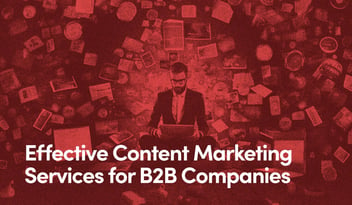Why Inbound Marketing Delivers Lasting Results

Inbound marketing has replaced traditional advertising methods as the most cost-efficient and sustainable method of generating quality leads.
That’s because barraging people indiscriminately with ads fails to drive long-term momentum and growth for businesses. Not to mention that today’s customers demand a less intrusive but more personal approach. In fact, 71% of them feel frustrated when businesses don’t deliver a personalized experience. This is exactly where inbound marketing comes in.
By building and nurturing relationships with your target audience before they make a purchasing decision, you earn more quality leads, build trust, increase ROI, save on long-term costs, and create sustainable growth.
This explainer serves as an inbound primer, helping you understand its key processes and advantages over traditional marketing efforts.
What Is Inbound Marketing?
The inbound marketing methodology was coined by leading marketing and sales CRM platform HubSpot. When properly executed, it helps nurture relationships by providing target audiences with helpful and relevant content during the buyer’s journey.
While typical outbound methods, such as cold calling or pay-per-click (PPC) ads, interrupt the user experience, inbound utilizes articles, white papers, podcasts, and other content to attract and engage consumers in a meaningful way.
How Does Inbound Marketing Work?
With Google processing more than 8 billion searches per day, it’s safe to say that the search engine is the primary destination for people looking for answers to a variety of questions.
For organizations operating in this environment, it’s essential to meet consumers where they are. That means you should be focused on producing strategic content that helps users find the answers they need while demonstrating that you’re a reliable source of information on a specific topic or industry.
Enhancing SEO: Building Relevance & Authority
As long as inbound marketers prioritize useful content and update previously published pieces to provide new value, they will help establish their clients as industry leaders with meaningful solutions to consumers’ most pressing and queried problems.
Why does this matter?
The ever-evolving algorithms utilized by Google and other popular search engines index content and determine rank based on relevance and authority.
While the former pertains to how closely content matches a search query, authority demonstrates trustworthiness and reputability, which is often established through producing high-quality content, generating backlinks, and more.
If inbound marketing is starting to feel like a bit of a long game, it’s because it is. But the results are well worth the wait.
It can take anywhere between three to six months to build your site’s ranking because your content needs time to mature within search engines. It’s not that much unlike planting a seed, carefully attending to it, and watching with awe as it eventually sprouts, establishes roots, and grows. The goal is to generate quality leads, with the hope that those users translate into customers.
Benefits of Inbound Marketing
In addition to the many advantages outlined above, the inbound methodology provides several other key benefits to your overall marketing strategy, including:
Generating Quality Leads
Businesses that blog earn 126% more monthly leads than those that do not. Plus, 60% of people who read about a product are more likely to purchase it, according to Canadian advisory firm Demand Metric.
Building Greater Trust
Consumers would rather do business with brands they trust.
Eighty-one percent of consumers consider trust an important factor in buying decisions, and 88% of marketers met their goals in trust and brand credibility through content marketing.
Increased ROI
Generating three times as many leads as outbound methods per dollar spent at a 62% reduced cost, inbound offers an incomparable return on investment.
Your content also continues to garner traffic—in contrast with PPC ads, which stop working when you stop spending.
Cost Effectiveness
Compared to purchasing trade show booths for $100 to $150 per square foot or PPC ads for $2 and $4, inbound marketing’s customer-driven approach minimizes reliance on solely paid methods for lead generation.
Since you’re attracting customers organically, you can devote more time nurturing leads and producing more relevant content.
Sustainable Growth
By generating momentum for your business, as a whole, inbound fuels more meaningful growth.
In establishing industry authority, you expand your audience as more people find your content organically. Investing in content creation, as opposed to one-off ads, enables you to provide value long after publishing. And prioritizing relationships over selling, helps build trust—turning prospects into returning customers, advocates, and your most vocal evangelists.
The Role of an Inbound Content Marketing Agency
While inbound does require time, patience, and effort, it offers businesses truly remarkable, lasting results.
By building quality content that addresses your prospects’ needs, you organically drive leads, develop trust, improve SEO, and ROI while saving on costs.
To maximize inbound benefits, partner with an experienced team to develop, strategize, and optimize valuable content that showcases your services and positions you as an industry leader.
With strategic content that showcases your value and expertise, you can enhance your customer base, nurture quality leads, and grow more sustainably, into the future.


